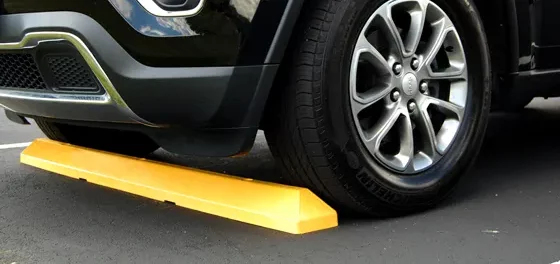Concrete vs. Recycled Rubber or Plastic Parking Blocks: Which is the Better Choice?
Explore the best parking block options for durability, maintenance, and sustainability.Recycled Rubber & Plastic Parking Blocks
✅ Pros:
♻️ Environmentally Friendly
Recycled rubber parking blocks and plastic parking blocks are made from repurposed materials, helping reduce landfill waste. In contrast, concrete production emits nearly a ton of CO₂ per ton of cement, making recycled options the greener choice.⚡ Easy to Install
Weighing only 50-100 lbs for rubber and even lighter for plastic, these parking blocks can be installed without heavy machinery—just bolt them down, and they’re ready to use.💪 Durable & Impact-Resistant
Rubber absorbs impact, preventing cracks, while high-quality plastic holds up well under pressure. Unlike concrete, they won’t crumble as easily under snowplow strikes or vehicle collisions.🚗 Safer for Vehicles
Concrete parking blocks with rebar sticking up from the top can scratch bumpers and chip paint upon impact. Rubber and plastic are more forgiving, reducing vehicle damage.🌟 Visibility & Customization
Many rubber and plastic parking blocks include built-in reflective strips for enhanced nighttime visibility and come in multiple colors. Plastic parking blocks often are molded in high visibility yellow to be easily visible when installed.⚠️ Cons:
📆 Slightly Shorter Lifespan
Rubber lasts around 10-15 years, while high-quality plastic can last over a decade. However, proper maintenance can extend their lifespan.💰 Higher Upfront Cost
Rubber parking blocks cost $50-$80, and plastic ranges from $30-$60. Although initially more expensive than concrete, they save money in installation upkeep and maintenance costs.Concrete Parking Blocks
✅ Pros:
⏳ Long Lifespan (Under Ideal Conditions)
Concrete can last 20-25 years if properly installed and maintained.🪨 Heavy & Stable
Weighing 200-300 lbs, concrete blocks won’t move easily—ideal for permanent setups.⚠️ Cons:
❄️ Snowplow Damage
Snowplows and heavy impacts cause cracks and breakage, leading to frequent replacements.🌍 High Environmental Impact
Cement production is a major CO₂ emitter, making concrete one of the least eco-friendly materials available.🔨 Heavy & Costly to Move
Concrete requires specialized equipment to install and relocate, adding to overall costs. Disposal at the end of their useful life is also highly problematic and may require you to call a contractor simply to remove and haul away.🚗 Harsh on Vehicles
One bump against a concrete parking block can mean chipped paint and damaged bumpers.Why Recycled Rubber & Plastic Take the Crown
When considering eco-friendliness, ease of use and installation, resilience, and cost savings, recycled rubber and plastic parking blocks clearly outshine concrete.- 🚜 Snowplow-Resistant: Rubber flexes; plastic holds firm—concrete crumbles.
- 🌎 Eco-Friendly: Made from recycled materials, reducing CO₂ emissions.
- ⚡ Easy Installation: No heavy machinery required.
- 💪 Durable & Vehicle-Friendly: Won’t damage cars like concrete does.
- 🔄 Customizable & Visible: Available in different colors with built-in reflectors.
🏆 Final Verdict:
- ✅ Recycled rubber is the best choice—durable, plow-resistant, and eco-friendly.
- ✅ Plastic is a close second for budget-conscious buyers who want a lightweight, sustainable option. Plastic also looks great.
- ❌ Concrete? Becoming an outdated choice due to environmental harm, snowplow damage, and high maintenance costs.
Upgrade Your Parking Blocks Today
While concrete has been the traditional choice, recycled rubber and plastic parking blocks are the future of parking lot design. They’re smarter, greener, and more practical, offering long-term durability with lower maintenance costs. Visit Traffic Safety Store to find the best parking block solutions for your needs.Need Help or have questions? Call us to order your Parking Blocks Today! Call us at 800-429-9030.

